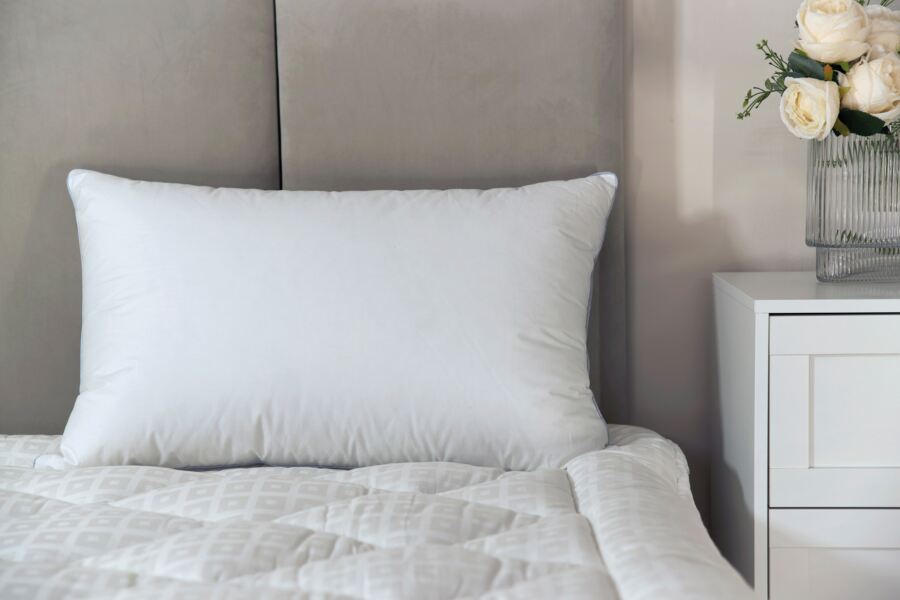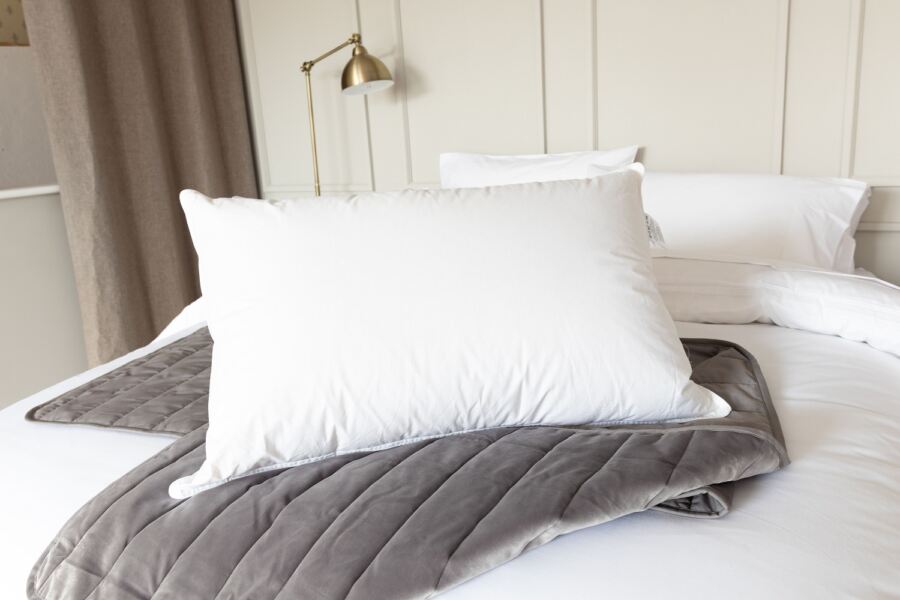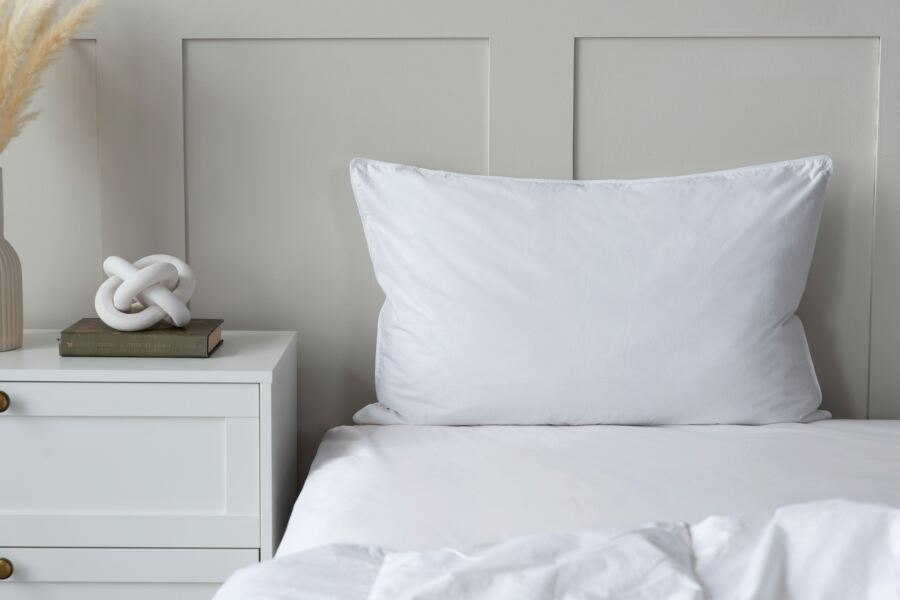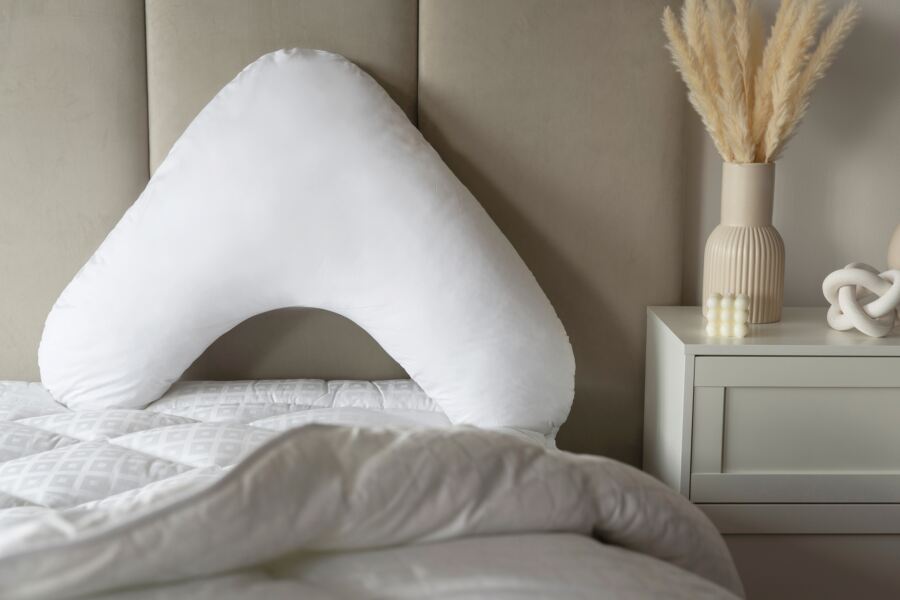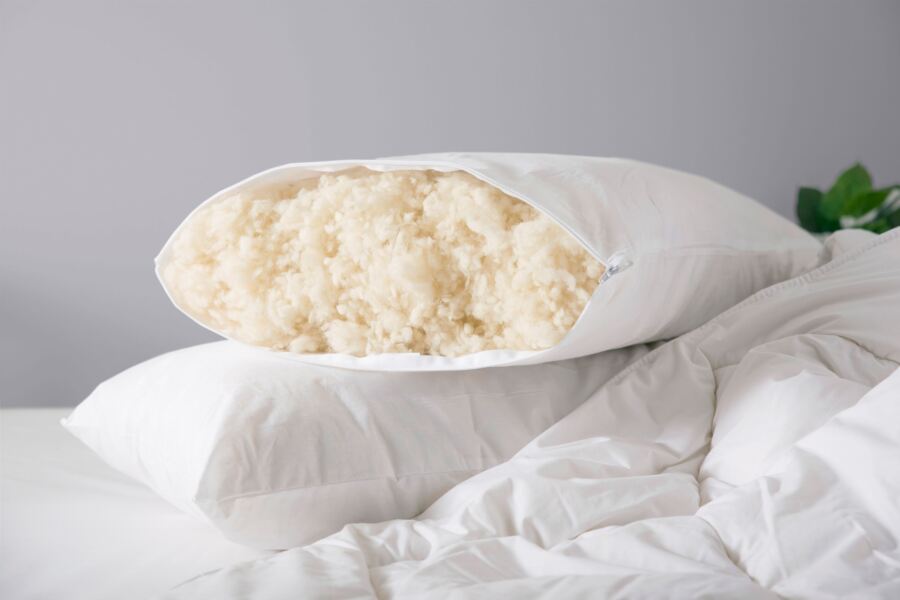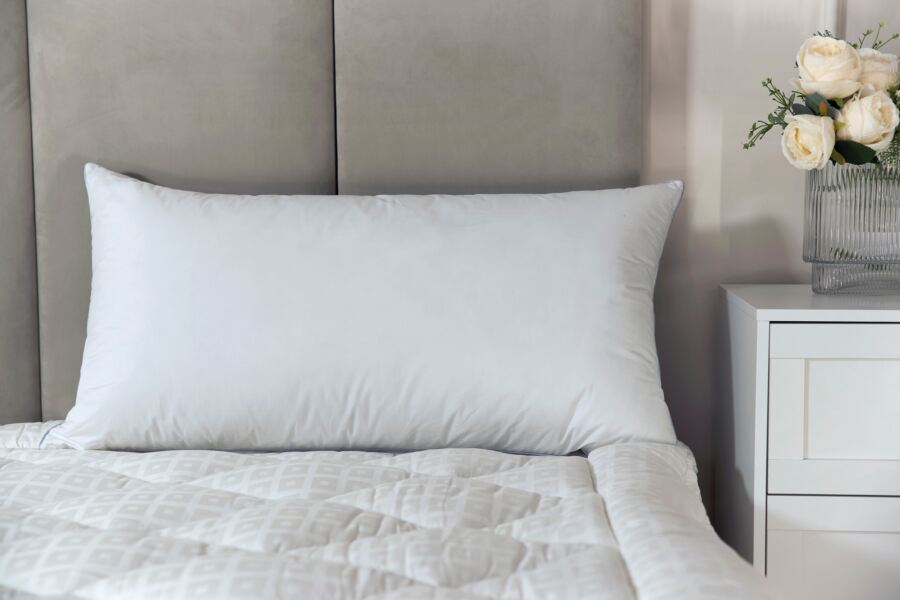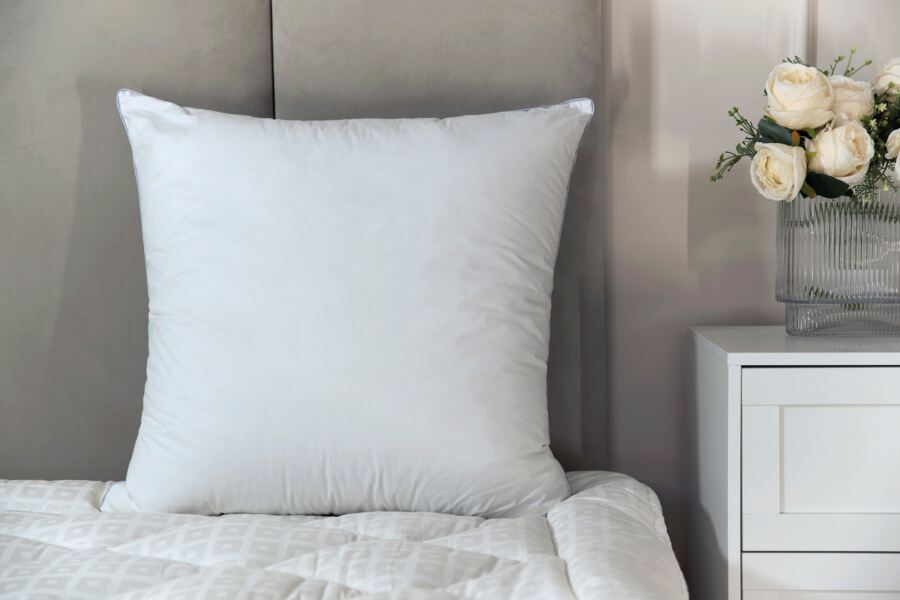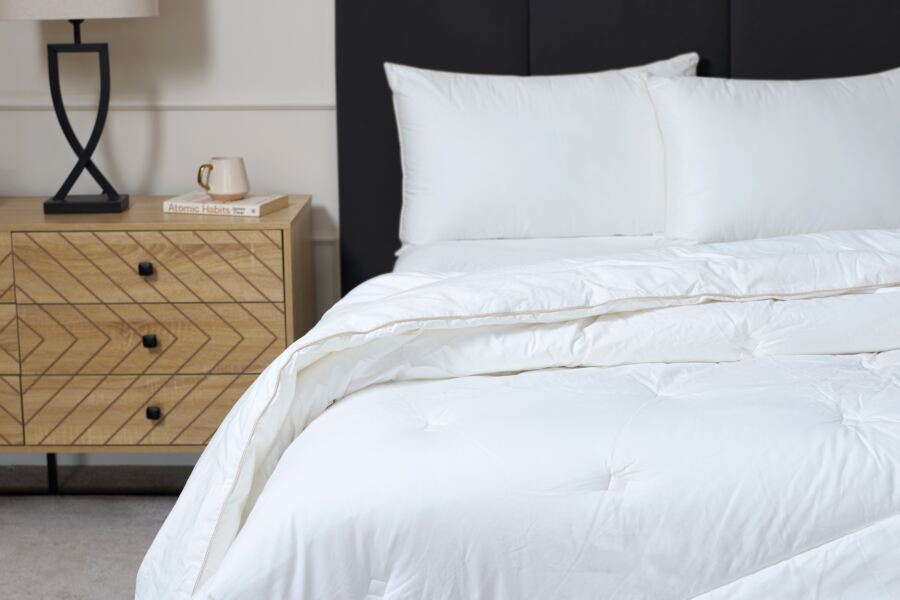Table of Contents
- Pillow Types Based On Your Sleeping Position
- Pillow Types Based On The Fill Material
- Pillow Types Based On Loft
- Pillow Types Based On Size And Shape
- Specialised Pillows
- Picking The Perfect Pillow
- FAQs
- Final Thoughts
Are you constantly waking up with aches and pains? Or has your pillow lost its height or is feeling a little too lumpy beneath your head? Then it may be time to invest in a new, high-quality pillow to completely transform your sleep experience.
Choosing the right pillow can be tricky since there are so many different types, shapes, and sizes on the market. That's where this guide comes in! Our sleep experts have put together a comprehensive look into each and every factor you need to consider to find the perfect pillow.
At Belledorm, we're invested in your comfort. So come with us as we take a look at how to find the right pillow type for every kind of sleeper.
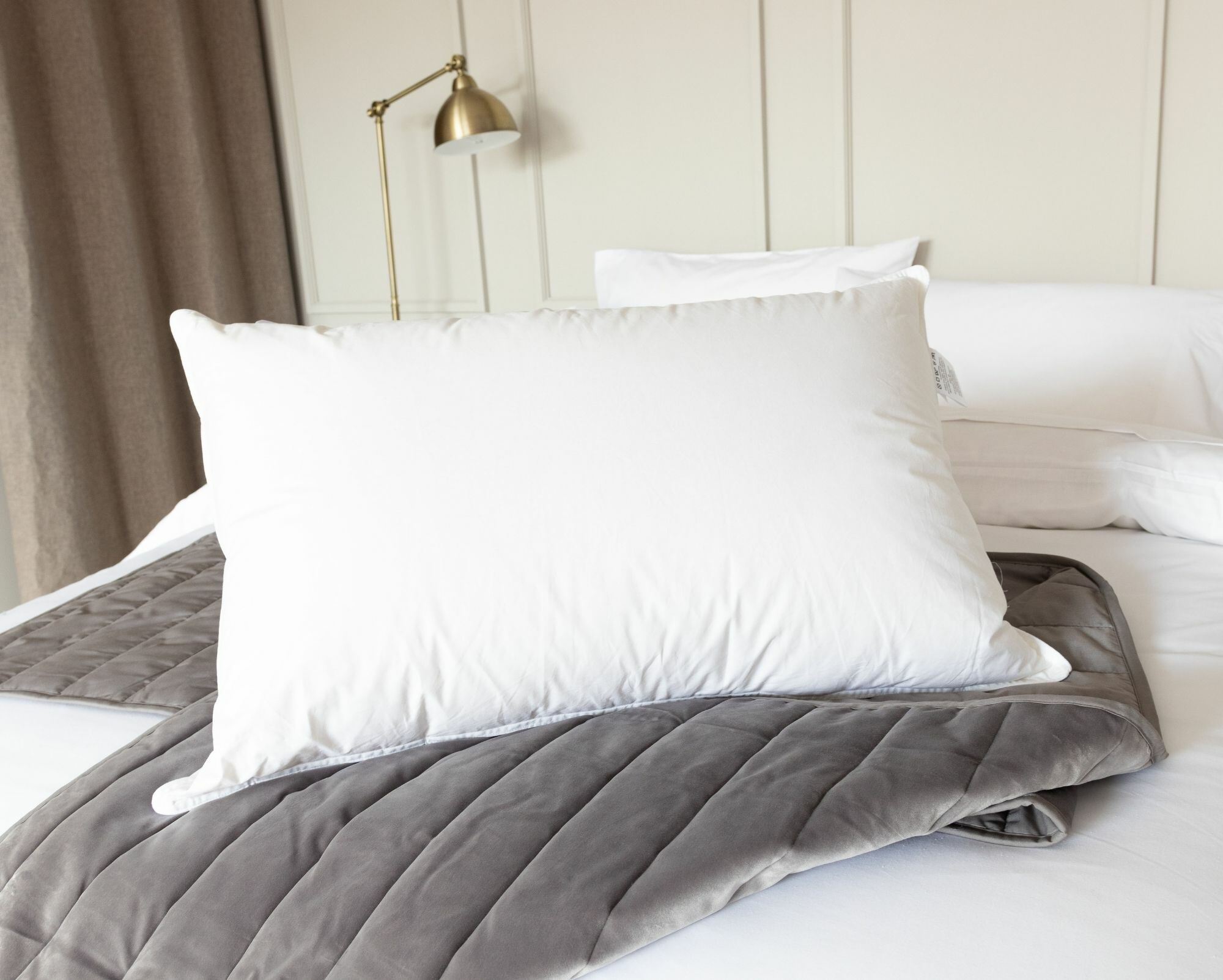
Pillow Types Based On Your Sleeping Position
The way that you sleep has a massive impact on the bedding that works for you - including your pillow. Although every sleeping style has its pros and cons, some positions can cause neck, shoulder or back pain. In turn, this can leave you feeling like you "must have slept funny last night".
If these aches and pains sound all too familiar, then it may be because you're not using the right pillow to support your head and neck while you sleep! The right pillow can make or break your sleep experience, so it's not a decision you're going to want to take lightly.
Common sleeping positions
While you may have heard about a range of sleeping positions (from the 'Starfish' to the 'Skydiver' or the 'Yearner'), all of these positions can be split into one of four main categories. Before we get into the ideal pillows for each position, it's important to familiarise yourself with the most common sleeping positions.
Side sleeper
As the name suggests, side sleepers sleep on their sides. Usually, this category can be split into two subtypes, namely the fetal position and the log position.
In the fetal position, you tend to curl your body with your legs pulled up towards your chest. Your arms can either be tucked in or stretched out, and you may even sleep with one arm under your head. This is similar to how a fetus is positioned in the womb, hence its name.
On the other hand, the log position is where you lie on your side with your legs straight and your arms by your sides.
While this position helps to maintain better spine alignment and can be super comfortable, it can also put a lot of pressure on your hips and shoulders. Luckily, picking the right pillow can help to alleviate a lot of this pressure.
Back sleeper
Back sleepers usually lie on their backs with their arms at their sides. Also known as the 'soldier' position, there are some variations of this position, too. Back sleepers may have their arms stretched out or folded over their chests, and may even lift their legs up and bend them outwards.
Like side sleepers, back sleepers have the benefit of a more relaxed spinal position. When you sleep on your back, you're less likely to have back, shoulder, or neck pain. However, you can increase your risk of snoring or sleep apnea in this position, which is why you'll want to pick out the perfect pillow.
Stomach sleeper
Stomach sleepers typically sleep with their head to the side and their arms wrapped around their pillow. If that sounds like you, then you'll want to listen up!
Although stomach sleepers reduce their risk of snoring, they put a lot of pressure on their spines and necks. This means that they're more likely to wake up with neck pain or other aches throughout their body.
The way that your spine curves when you sleep on your stomach can cause a lot of pain and discomfort, but it's tricky when every other sleeping position feels uncomfortable, too. Although this isn't the optimal sleeping position, choosing the right pillow can help to improve your sleep quality while you sleep on your stomach.
Combination sleeper
Mixed or combination sleepers tend to change their sleeping position throughout the night. So if you're prone to tossing and turning, then you may be a combination sleeper. Generally, these sleepers start in one position and switch over at least once as they sleep. For example, you may start on your back and then flip onto your side or stomach.
The great thing about this sleeping position is that it reduces your risk of sleep-related problems that are usually associated with one specific position. However, it can also be challenging to get comfortable or pick the perfect pillow, since you'll need to adjust it every time you move.
Pillows for every sleeping position
Once you're familiar with the most common sleeping positions and where your sleeping style fits into that, you can start to narrow down your search for the right pillow.
Although your pillow preferences might be slightly different to the standard choices based on your sleeping position, you can use these suggestions as a starting point for finding your ideal type of pillow.
Pillows for side sleepers
When you're sleeping on your side, it's important to maintain proper head and neck alignment.
Ideally, your pillow should fill the gap between your ear and your shoulder to keep your spine in a neutral position. Additionally, side sleepers need a supportive and firmer pillow to help keep their head in the right position.
An orthopaedic or cervical pillow is a fantastic choice for any side sleeper since they have a curved shape for extra support.
Pillows for back sleepers
Back sleepers should choose a pillow that helps to support the natural curve of their neck while also keeping their head in a neutral sleeping position. This means that the pillow shouldn't be too high or too low.
The best pillow for back sleepers will typically be a medium-firm pillow with a good amount of support for their neck. Alternatively, a standard pillow with good loft or a memory foam pillow is an excellent alternative.
Pillows for stomach sleepers
It may be even more important for stomach sleepers to choose the right pillow since this sleep position is the most strenuous on the neck and back. In fact, plenty of stomach sleepers complain about neck pain or lower back problems.
Since you want your head to be as low as is comfortable, you may want to pick a flat, soft pillow to keep your neck as relaxed as possible. There are also special pillows that are designed for stomach sleepers that have specific shapes and lower lofts to help you get a better night's sleep.
Pillows for combination sleepers
Combination sleepers are slightly trickier to cater for when it comes to the perfect pillow. Still, there are some versatile pillow choices that may be able to adapt to their ever-changing sleeping position.
Pillows with adjustable lofts or pillows made from shredded memory foam are great choices. They can help to give you the support you need throughout the night while also adapting to your sleep position when you're switching between them.
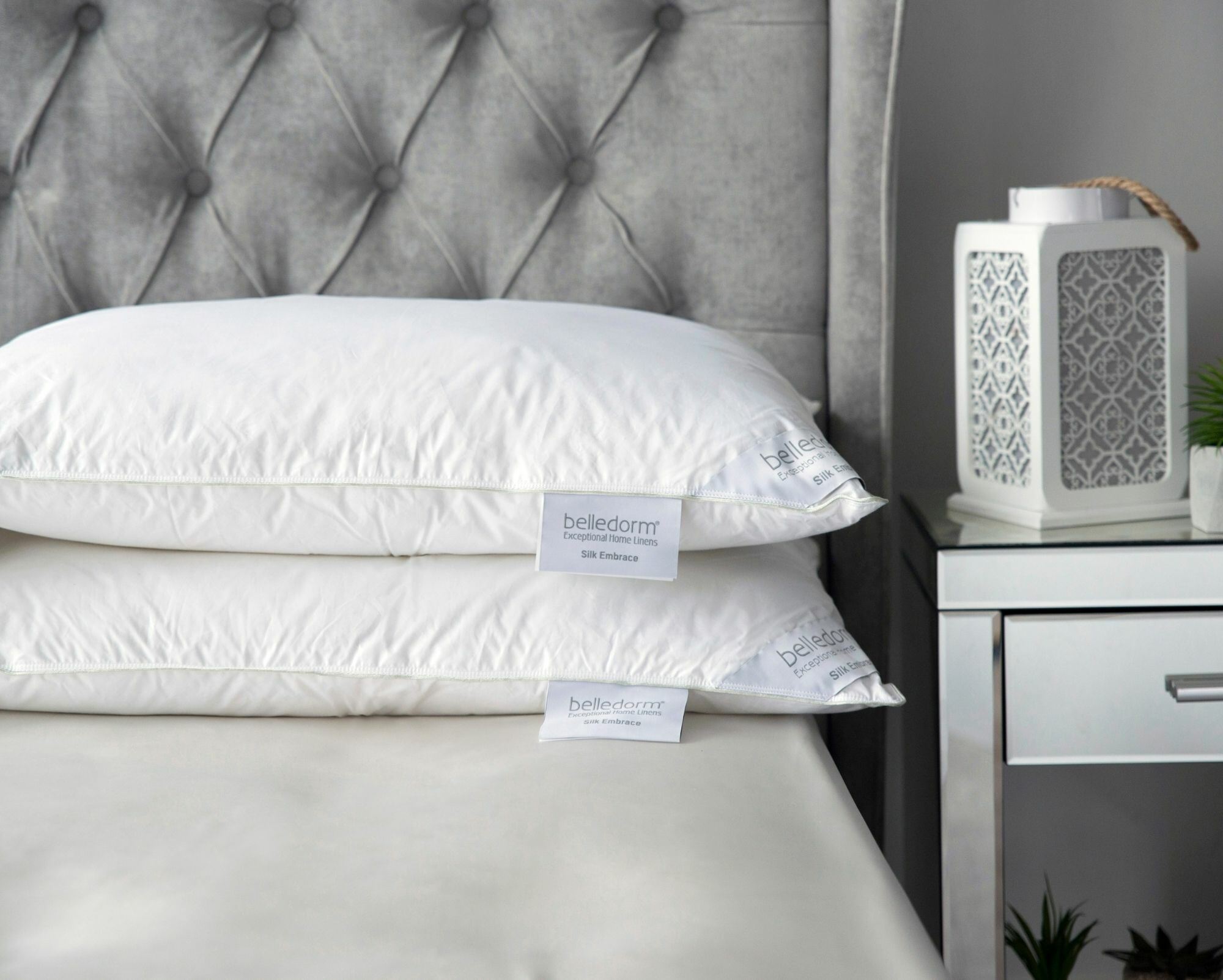
Pillow Types Based On The Fill Material
The type of materials that are used as pillow fillings can directly impact how comfortable your pillow is. Some materials may be better for cooling pillows, while others tend to retain heat. At the same time, the firmness of the pillow is mostly reliant on what material filling is used. After all, some fillings are naturally softer while others are designed for support and are therefore less plush.
All in all, the material you choose will depend on what you like, and what makes you most comfortable. While some materials work well for certain sleeping styles, the bottom line is that you need to pick one that suits your needs.
Usually, you'll find pillows with various types of filling, both natural and synthetic. This can affect how the pillow feels, as well as determine whether the pillow is hypoallergenic or not. Below, we've listed the most common pillow fillings, what they're good for, and who they're likely to work best for.
Memory foam
Memory foam pillows are made from polyurethane foam and are designed to conform to the shape of your head and neck. This is fantastic for back sleepers or combination sleepers who tend to turn over onto their backs during the night.
The contouring action of a high-quality memory foam pillow can help to distribute the weight of your head more evenly, which can reduce discomfort. Plus, it promotes proper spinal alignment, meaning no more aches and pains!
Although memory foam pillows are incredibly durable since they retain their form for more time than standard pillows, they may also trap heat. This isn't ideal for hot sleepers or anyone who suffers from those dreaded night sweats.
Pros:
-
Good for a supportive pillow
-
Ideal for pressure relief
-
Durable and long-lasting
-
Available in hypoallergenic options
Cons:
-
Some models may retain too much heat
Latex
Latex pillows are either made from natural or synthetic latex foam. It's important to remember that while natural latex is eco-friendly, the same can't be said for a synthetic pillow with a latex filling. However, a synthetic latex pillow is usually cheaper than its counterpart.
No matter which one you choose, a latex pillow is excellent for consistent support for your head and neck. They are also naturally hypoallergenic and resistant to dust mites and other common allergens.
Pros:
-
Good support and resilience
-
Latex pillows are naturally hypoallergenic
-
Exceptional longevity
Cons:
-
May be slightly pricier than other pillows
-
Latex pillows are sometimes heavier than others
Feather and down
Generally, you can buy feather pillows, down pillows, or a combination of the two. A duck down and feather pillow will often use goose or duck feathers, which are what give them a plush, luxurious feel. There are also down alternative pillows, which are a great hypoallergenic alternative to traditional down pillows.
The best part of these pillows is that they have more airflow than a standard pillow, which is great for hot sleepers. On the other hand, they are also naturally soft, which means they may not give you the support you need depending on your sleep position.
If you want a fluffier pillow, it may be good to note that a goose down pillow is usually softer and therefore better for stomach sleepers.
Pros:
-
Luxurious
-
Good choice for a soft pillow
-
Natural airflow
-
Ideal for hot sleepers
Cons:
-
May not offer enough support for certain sleepers
-
Down pillows can potentially trigger allergies in sensitive individuals
Polyester fiberfill
Polyester fiberfill is perhaps one of the most affordable pillow fillings on the market. But while it may be more accessible and easier on your wallet, it's not an ideal pick for every type of sleeper. This type of pillow is usually hypoallergenic and is a softer pillow that can help with neck pain if you tend to sleep on your stomach.
Although this is a naturally soft pillow, it's also more likely to lose its shape. And, when you're buying a new pillow, you want it to last. But if you're looking for a cheap option that's easy to replace, then this is a good choice.
Pros:
-
Budget-friendly
-
Hypoallergenic options available
-
Easy to clean and care for
Cons:
-
Limited support
-
May become flatter over time and lose its shape
Buckwheat
Buckwheat may be less well-known than other pillow fillings, but it's becoming increasingly popular with eco-conscious sleepers.
These pillows use natural buckwheat hulls to fill them up, which can usually be removed if you want to adjust the pillow to suit your needs. This is what makes them customisable for your sleeping style and invaluable for combination sleepers.
The best part about these pillows is that they have good airflow, making them breathable and cool for hot sleepers. However, some models can be a little noisy when you adjust them, so it's important to test this type of pillow out before you settle on it as your go-to.
Pros:
-
Adjustable support for combination sleepers
-
Good breathability
-
Natural and eco-friendly
Cons:
-
Can potentially be heavier than other pillows
-
May be noisy when you're adjusting it
Cotton
Another great choice for an eco-friendly pillow is one that is filled with all-natural cotton fibres. Since cotton is hypoallergenic, these pillows work wonders for people who are sensitive to allergens and dust, and they can also help you sleep through the night - allergy-free!
If you're looking for a breathable and soft pillow, this is the type of pillow for you. In general, it works well for a combination sleeping style, but it can also work for a side sleeper who wants more cushioning beneath their head. It's important to note, though, that these pillows don't have the same support as latex or memory foam pillows.
Pros:
-
Ultra soft
-
Breathable
-
Eco-friendly and hypoallergenic
Cons:
-
May lack the necessary support for some sleeping styles
Microbeads
Microbead pillows use small polystyrene beads to fill them up, which is great for a pillow that conforms to your head and sleeping position. These lightweight pillows are easy to adjust to your preferences and can be really comfortable, but they may not have the right amount of support for certain sleepers.
While these pillows may also be more affordable than others, they lack the same durability as a high-quality latex or memory foam pillow. They are, however, a cheaper alternative for cooling pillows when compared to feather pillows.
Pros:
-
Easy to adjust to your sleep position
-
Lightweight
-
Conforms to your head and neck for a comfortable sleep
Cons:
-
Not as durable as a firmer pillow
-
Limited support for back sleepers
Wool
A wool pillow is made using natural sheep's wool or a blend of wool fibres, depending on the brand and model. If you want a comfortable pillow that also provides consistent support over time (including sustaining its loft and fluffiness), a wool pillow may be the right pillow for you.
Wool is extremely breathable and has natural moisture-wicking properties, which is great for temperature regulation. In turn, this means that these pillows can keep you cool in summer and warm in winter.
Pros:
-
Hypoallergenic
-
Moisture-wicking for a comfortable, dry sleep
-
Fantastic temperature regulation
-
More likely to retain its shape for long periods
Cons:
-
Wool doesn't have the same contouring effect as a memory foam pillow
Silk
Unsurprisingly, silk pillows are filled with silk fibres, giving them a luxurious feel. Typically, a silk pillow will be on the softer side and will work well for anyone who wants a plush, low-loft sleeping surface. Plus, silk is known to reduce friction on your hair and skin, which can help prevent hair damage and wrinkles!
Since silk is naturally hypoallergenic, you won't have to worry about suffering from allergies, either - even in the summertime. And, while they may be softer than some other pillows, they're more likely to retain their shape compared to a synthetic pillow.
Pros:
-
Exceptionally soft
-
Hair and skin benefits
-
Naturally resistant to allergens and dust mites
-
The perfect pillow for stomach or combination sleepers
Cons:
-
Silk pillows usually require more maintenance than fillings like memory foam to maintain their loft
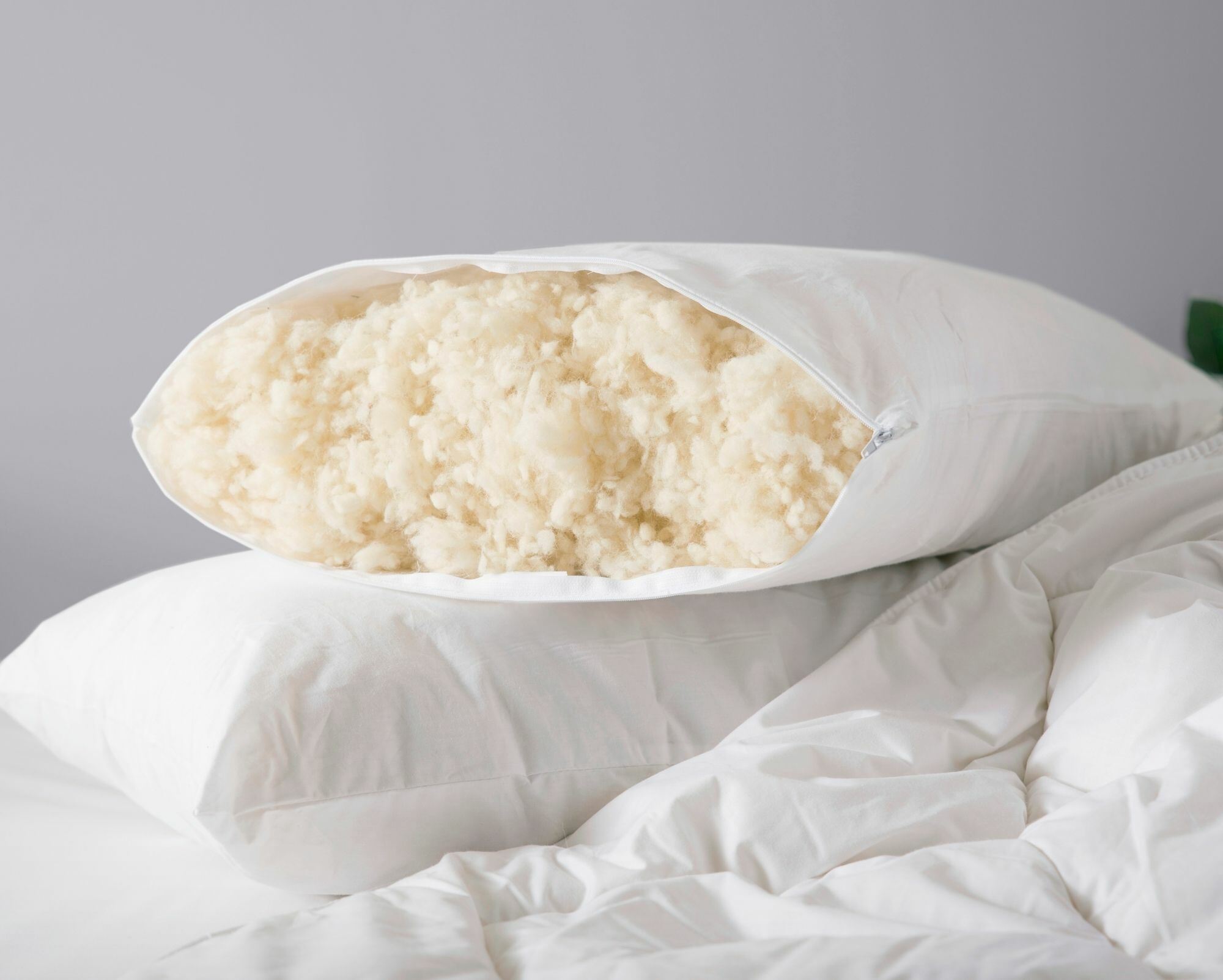
Pillow Types Based On Loft
Pillow loft refers to the height or thickness of a new pillow. You can usually determine the loft of your pillow by looking at it side-on and seeing how thick it is. Of course, this can determine how comfortable your pillow is, since loft is usually tied to the firmness of a pillow (but this isn't always the case).
Part of choosing the right pillow is weighing up how much height you want from your pillow with your sleep position. For example, stomach sleepers will want a thinner pillow with less loft to keep their neck at the perfect angle while they sleep.
Types of pillow loft
Generally, pillows can be divided into three loft types. These include:
-
Low loft: Low loft pillows are typically on the thinner side and have less height. They're best suited to people who sleep on their stomachs or who want a more flat or level sleeping surface. In some cases, individuals may prefer to have two low-loft pillows to sleep with rather than one high-loft pillow.
-
Medium loft: For a pillow with a moderate thickness, a medium-loft pillow offers the perfect balance of support and comfort. So, if you're a back sleeper, this could be the right pillow for you! They can also work for combination sleepers, depending on how you switch positions throughout the night.
-
High loft: Generally, a firmer pillow will have more loft than others. However, one of the exceptions to this rule is feather pillows, which are naturally plush. A good example of a high-loft, firm pillow is a memory foam pillow. In most cases, pillows with a higher loft work well for side sleepers, since they help to keep proper spinal alignment without too much strain on the head and neck.
Why is pillow loft important?
There are several reasons that pillow loft is important when you're choosing the right pillow. Some of the main reasons are:
Spinal alignment
The right pillow loft is essential for maintaining the correct spinal alignment when you sleep. When your head and neck are supported (at the right height), it helps to keep your spine in a neutral and relaxed position. In turn, this really helps to reduce the risk of neck pain and stiffness when you wake up.
Comfort
The loft of a pillow is one of the main factors in how comfortable you are at night. After all, you don't want your neck positioned so awkwardly that you wake up with a crick in your neck!
If the loft is too high, it can feel like your chin is being forced toward your chest. This can cause upper-body muscle tension as well as uncomfortable neck pain.
On the other hand, a loft that is too low for your sleep position can make it feel as if your head is falling backwards, which can cause strain on your neck and your shoulders.
Neither of these situations is ideal, which just shows how much loft can affect your overall comfort.
Support
Besides the pillow filling, the loft may be next in line as the most important factor in determining how supportive a pillow is.
For example, side sleepers typically need a higher loft to fill the space between their head and their shoulder. This helps to support their head, but may not be the best choice for other sleeping positions.
Back and stomach sleepers may need pillows with a much lower loft to give them a flat sleeping surface and give their body the support it needs.
Temperature regulation
Although it may not seem like an obvious connection, your pillow's loft can actually affect how much heat it retains!
Because high-loft pillows are usually denser than others, they tend to be less breathable and trap more heat. Low-loft pillows will have more airflow, and therefore retain much less heat (say goodbye to night sweats!).
It's important to remember, though, that some pillows use certain cooling technologies to help pillows release unnecessary heat, regardless of their loft.
How to choose the right loft
Finding the right pillow loft can be tricky since it's hard to gauge what a pillow will feel like just by looking at it. That's why we've put together a three-step guide on choosing the right pillow loft for a good night's sleep.
Here's how to pick the right pillow thickness:
-
Think about your sleep position: Your sleeping style is the best place to start to help you choose the right pillow. Side sleepers usually need a higher loft, while back sleepers need a medium loft to lift their head slightly. Lastly, face-down sleepers need a thinner pillow with a low loft to keep their head at the best angle.
-
Experiment: It may take some trial and error to find the right pillow loft. Ideally, you'll want to try out different pillow thicknesses to see which one suits you best. If you have the chance to lay down on the pillow, then we'd recommend taking this opportunity to imagine how it will feel when it's on your bed. But if you're ordering it online, be sure to check the return policy!
-
Ask an expert (if necessary): If you have sleep-related conditions like sleep apnea or suffer from back and neck pain, it may be a good idea to consult a sleep specialist or healthcare expert. These professionals can advise you on the type of pillow you'll need to cater to your specific condition. For instance, people with sleep apnea may benefit from a wedge pillow with a gradient loft.
Pillow Types Based On Size And Shape
Choosing the right pillow size and shape can impact how comfortable your sleep is and take your sleeping experience from drab to fab! Of course, the main function of your pillow is to support your head, neck, shoulders, and ultimately your back as you sleep. Picking the right pillow can ensure that your neck is in line with your spine, which is crucial for a restful night's sleep.
Pillow size options
Besides picking your ideal pillow based on your sleep style and preferences, the size of your bed can also impact the size you need. For example, a larger bed like a queen or king-sized bed may need a slightly longer pillow to fit correctly. However, smaller beds like twin-sized beds may be better suited to a standard pillow.
Before we get into pillow sizes, it's important to remember that they may differ slightly, depending on the manufacturer or brand that you're buying your new pillow from. It may also vary between regions, so be sure to check out the size guide on the manufacturer's site to ensure you're getting the right size for your bed.
Below, you'll find a list of the most common pillow sizes on the market:
Standard
A standard pillow is the most versatile size and is the 'generic' size you'll find on the shelves. Usually, they fit well on twin and full-size beds, and two of them fit perfectly (side-by-side) on a queen bed. These pillows typically measure around 51 cm x 66 cm.
Queen
Queen pillows are only slightly bigger than standard pillows, measuring around 51 cm x 76 cm. They fit well on a queen-size bed, hence their name, and have a little more length on them. This also makes them perfect for sleepers who toss and turn in their sleep, since they won't roll off of their pillows if they roll too far!
King
King pillows are designed to fit on a king-size bed and are the biggest of the standard pillow sizes. They usually have a much bigger surface for sleepers who enjoy a larger sleeping surface, and measure 51 cm x 92 cm.
These pillows are too big for traditional full or twin beds and may be too long for queen beds as well. Still, they can be used as decorative pillows on smaller beds in some cases.
Body pillows
Body pillows come in various lengths, but are typically made to support your entire body. That means that these super-long pillows have an average measurement of around 51 cm x 137 cm. Most of these pillows are used by side sleepers who want something to cuddle at night, or by pregnant women to help ease their discomfort and provide them with additional support.
Pillow shape
Although most people may think that there are only different pillow shapes between a standard pillow and novelty pillows, that's definitely not the case! There are several different pillow shapes on the market that each serve a unique purpose, which can influence your decision on what pillow will work for you.
While the list below definitely isn't exhaustive, it should give you a better idea of the type of pillow you're looking for.
Standard shape
Standard pillows are the most common style and have a rectangular shape. They may come in various lengths, but they all have the same shape and fit certain bed types based on their measurements.
Square
Square pillows are mostly used as decorative pillows, but they can also be used as additional support for your back when you're sitting up in bed. Generally, a square pillow has the same length and width despite coming in different sizes. For example, they may be 46 cm x 46 cm or 66 cm by 66 cm, which changes their size but not their shape.
Contoured or cervical
Contoured pillows are really unique and have a design that is made to support your neck and your head. These pillows typically have a dip where your head will go, which cradles your upper body for additional comfort.
Wedge
Most popular for sitting up in bed, wedge pillows are triangular in shape and usually have a gradual incline to help elevate your upper body. This means that the bottom of the pillow that is beneath your back will be the thinnest and gradually get thicker toward the top where your head goes.
Wedge pillows can be helpful for people who suffer from respiratory issues or acid reflux, and may be recommended by a doctor for people with certain conditions.
Round or bolster
A bolster pillow is shaped like a cylinder. And, despite also being called round pillows, they are longer than regular pillows. Instead, the name comes from the fact that they have rounded edges, which is great for adding to your pillow pile or as lumbar support when you're sitting up in bed.
Specialty shapes
In some cases, you may come across pillows with unique shapes and sizes. While some of these shapes are mostly designed for their novelty (think of a heart-shaped pillow that you may use for decoration on Valentine's Day), there are others that serve a specific purpose.
A good example of this is a V-shape pillow, which can be used for side and back sleepers. Of course, it can also help your bed look super stylish, but it can work well to give you a better night's sleep.
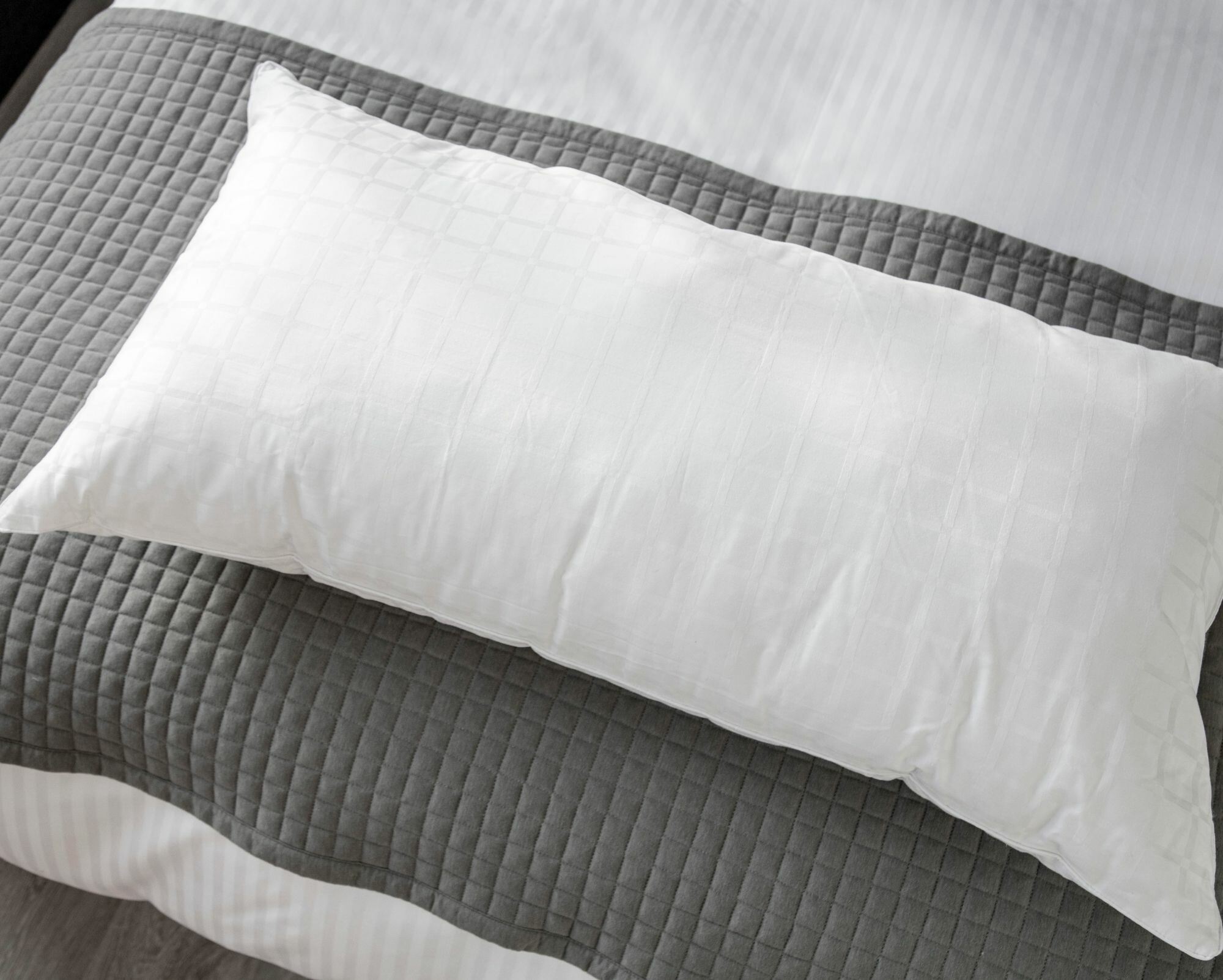
Specialised Pillows
If you're looking for the perfect pillow to suit a need other than standard sleeping support, then you may want to delve a little deeper into the world of specialised pillows. While there may be pillows for anything and everything, three specific types of pillow stand out from the rest as the most widely used. These include pregnancy, orthopaedic, and travel pillows.
Pregnancy pillows
Pregnancy or maternity pillows are designed to suit the needs and changing body of a pregnant person. They are usually quite long (typically the same length as your body), and have a C or U-shaped design.
These pillows are helpful for cushioning around the belly, hips, and back. In turn, this alleviates the pressure that a growing belly may put on the spine.
In some cases, these pillows can serve a dual purpose and be used as a breastfeeding pillow as well!
Orthopaedic pillows
Orthopaedic pillows are made for musculoskeletal issues that may potentially cause pain. The most typical example of an orthopaedic pillow is a memory foam pillow since it's made for comfort and support for spinal alignment.
For some people, these pillows aren't only used for their heads as they sleep. Instead, they're also used under the back or legs to relieve pressure from their bodies.
Travel pillows
If you're planning on going on a trip, then a travel pillow may be an invaluable part of your luggage. Travel pillows are made to support your head and neck when you need to sleep upright (in a plane or car, for instance).
Although there are plenty of standard travel pillows, there are also those that can be adjusted for your comfort, such as an inflatable neck or memory foam pillow.
Picking The Perfect Pillow
So, with so much information to absorb and consider, how exactly do you pick the best pillow? Well, besides the factors we've mentioned and your sleeping position, some of the other points you may need to mull over include:
Budget
When you're picking out the best pillow for your needs, you don't want to break the bank! Instead, you'll want to find the perfect balance between price and comfort. Pillows come at various prices, from budget pillows to high-end sleeping aids. And, while more expensive pillows may have certain benefits, there are also budget options that can work just as well for your personal preferences.
Personal preference
Just because a pillow is advertised as being the 'best pillow' for your sleeping position or for certain features doesn't mean that you have to buy it. You may be a side sleeper (which is usually complemented by a firmer pillow like memory foam), but find it difficult to sleep on a pillow that is too hard.
In this case, you may want a pillow with a good loft that is also softer and therefore more comfortable for you. That means that the best pillow for your needs would more than likely be down pillows or something similar. Remember, you always want to listen to your body and adjust your pillow to work for you and not the other way around.
Allergies
If you're sensitive to allergies and dust mites, the right pillow should address your sleeping concerns. You may want to look for hypoallergenic pillows that are designed to resist common allergens or invest in a high-quality pillow protector. This will completely envelop your pillow and reduce the risk of it filling up with dust or dander.
Durability
When you're paying a high price for a pillow, you're going to want it to last! After all, you don't want to have to replace your pillow every few months when a high-quality pillow can last for over a year.
Although some pillows are less durable (like synthetic pillows), they're easily replaceable since they're budget-friendly. However, if you're putting a lot of money into your new pillow, you may want to pay special attention to how durable the material is.
Maintenance
Life can easily become hectic and small things like caring for your pillow can end up slipping your mind. But, without proper care, some pillows may be more likely to wear down and become uncomfortable within a few months.
When you're sussing out a new pillow, you should always be sure to check out its care instructions and ensure that you can adhere to these instructions to keep them clean and in shape.
FAQs
How often should I replace my pillow?
Typically, you should try to replace your pillow every 1 to 2 years. However, this is dependent on the type of pillow you have and how well it has been maintained.
Over time, almost any pillow will lose its shape and fluffiness. When this happens, it may be time to assess whether or not you want to replace it, or whether some good old TLC can revive your pillow. Still, if your pillow is lumpy or flat, or if you're starting to wake up with pain or allergies, it may be time to pull the plug on your current pillow and invest in a new one that's right for you.
How do I know if a pillow is right for me if I'm buying it online?
One of the hardest things to do is find the right pillow when you're buying them online. But that doesn't mean that you can't find the perfect pillow on an online site. Rather, you should pay attention to the specifications and look for a pillow with a return policy that allows you to test it out. Of course, reading customer reviews can also help you to gauge what other customers thought about the product.
Can I machine wash my pillow?
There are plenty of pillows that can be washed, but at the same time, there are plenty of them that can't. Ideally, you'll want to check the manufacturer's website or the label of your pillow to check for any maintenance or washing instructions.
Typically, memory foam and latex pillows cannot be washed at all. However, most synthetic or down pillows are machine washable. The best way to protect a pillow that can't be washed is to use a pillow protector, which can then be removed and washed before putting it back onto your pillow.
Are expensive pillows always better?
Expensive pillows aren't necessarily better than others. Just because a pillow has a higher price tag doesn't mean that it uses higher-quality fillings or coverings. While some pillows, like memory foam or feather pillows, are typically more expensive than synthetic pillows, there are still great budget options for every type of pillow.
The bottom line is that you shouldn't buy a pillow based on its price. Rather, you should test it out and make sure that it's going to keep you comfortable all night long!
How can I protect my new pillow from wear and tear?
The easiest way to protect your new pillow and prolong its life is to use a pillow protector or a zippered pillowcase. This will stop dust mites and dirt from getting onto your pillow, and make it even easier to clean!
Instead of cleaning your entire pillow, you simply need to fluff it up and wash the pillowcase to keep it in tip-top shape. With the right maintenance and cleaning, your pillow should keep its shape and support for a while to come.
Final Thoughts
In the quest for the ideal pillow, there is no one-size-fits-all answer. While there are some pillows that work well for certain situations and sleeping positions, the final decision still rests with you. Your choice should always depend on your needs and budget, although having a good idea of where to start and how to narrow down your choices can help tremendously!
With Belledorm's pillows, you're guaranteed to have a good night's sleep and, ultimately, find the pillow of your dreams!

